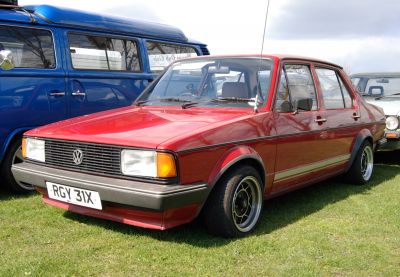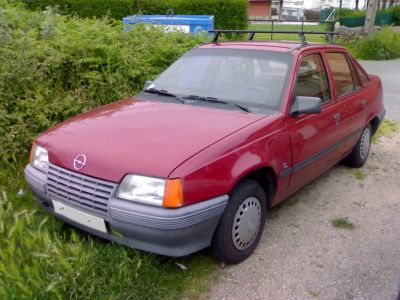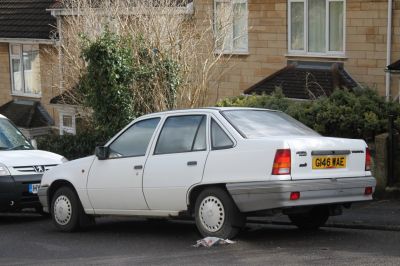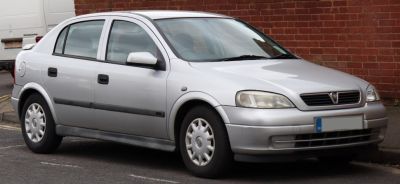 1997 Daewoo Lanos (KLAT) Dimensions, Size & Specs
1997 Daewoo Lanos (KLAT) Dimensions, Size & SpecsMeasurements of the 1997 Daewoo Lanos, engineered for optimal performance and comfort
| Dimensions | |
|---|---|
| Length: | 4237 mm166.8 in13.9 ft |
| Width: | 1678 mm66.1 in5.5 ft |
| Height: | 1432 mm56.4 in4.7 ft |
| Trunk Capacity: | 320 liter11.3 cu ft |
| Trunk Capacity (Max): | 960 liter33.9 cu ft |
| Weight Specifications | |
| Curb Weight: | 1005-1060 kg2216-2337 lbs |
| Maximal permitted Weight: | 1535-1595 kg3384-3516 lbs |
| Tire Specifications | |
| Rims Sizes: | 13-inch rims:
|
| Tire Sizes: |
|
The Daewoo Lanos Sens (KLAT), produced from 1997 to 2002, is a compact sedan designed to offer practical dimensions and efficient use of space. Measuring 4237 mm (166.9 inches) in length, 1678 mm (66.1 inches) in width, and standing 1432 mm (56.3 inches) tall, the Lanos Sens fits well within the compact segment, striking a balance between interior space and maneuverability.
With a curb weight ranging from 1005 to 1060 kilograms (2216 to 2337 pounds) and a maximum permissible weight between 1535 and 1595 kilograms (3385 to 3516 pounds), this model maintains a lightweight profile that contributes to fuel efficiency and nimble handling. The sedan's luggage capacity is practical for daily use, offering 320 liters (11.3 cubic feet) of trunk space with all seats in place and expanding significantly to 960 liters (33.9 cubic feet) when the rear seats are folded, providing versatility for transporting larger items.
The wheel setup includes rims sized at 5.5J x 13 and 5.5J x 14, paired with tires that typically range from 175/50 R13, 175/70 R13, to 185/60 R14, demonstrating a focus on a comfortable ride and stable road grip.
Overall, the Daewoo Lanos Sens (KLAT) represents a well-sized, economical sedan option from the late 1990s and early 2000s, ideal for urban drivers needing a compact vehicle with flexible cargo options and reasonable performance metrics.
Discover the standout features that make the 1997 Daewoo Lanos a leader in its class
Have a question? Please check our knowledgebase first.
The Daewoo Lanos (Sens) Lanos (KLAT), produced from 1997 to 2002, features exterior dimensions that foster a practical and maneuverable sedan size. It measures 4237 mm (approximately 166.8 inches) in length, making it compact yet suitable for urban driving. Its width is 1678 mm (about 66.1 inches), ensuring comfortable seating for passengers without feeling cramped. The height stands at 1432 mm (around 56.3 inches), contributing to a low-profile, aerodynamic silhouette. These dimensions combine to offer a balanced blend of interior comfort and ease of parking or navigating through tighter city streets.
The Daewoo Lanos (Sens) sedan has a curb weight ranging between 1005 kg to 1060 kg (2215 to 2337 lbs) and a maximum gross vehicle weight between 1535 kg and 1595 kg (3385 to 3516 lbs). This relatively lightweight profile contributes to its nimble handling and responsive steering, making it an agile option for city and suburban driving. The modest weight also helps with fuel efficiency, as the engine does not have to work as hard to move the vehicle. However, the maximum weight capacity indicates the car’s ability to safely carry passengers and cargo without compromising performance or safety standards.
The Daewoo Lanos (Sens) offers a luggage capacity of 320 liters (approximately 11.3 cubic feet) with all seats in place, which is adequate for everyday grocery shopping, small luggage, or daily carry items. When the rear seats are folded down, the cargo space expands significantly to 960 liters (around 33.9 cubic feet), providing ample room for larger items, bulky gear, or extended trips. This flexibility makes the Lanos (Sens) a practical choice for drivers needing a sedan that can adapt from daily commuting requirements to occasional larger cargo needs.
The Daewoo Lanos (Sens) uses rims sized at 5.5J x 13 and 5.5J x 14, accommodating tire sizes of 175/50 R13, 175/70 R13, and 185/60 R14. This variety of tire sizes offers flexibility for drivers prioritizing different driving characteristics, such as ride comfort, fuel economy, or road grip. The smaller 13-inch rims with 175/50 or 175/70 tires enhance fuel efficiency and maneuverability, while the 14-inch rim with 185/60 tires provides better handling and stability, especially at higher speeds or on rougher roads.
Yes, the Daewoo Lanos (Sens) comfortably fits into a standard garage. With a length of 4237 mm (approximately 166.8 inches or 13.9 feet), a width of 1678 mm (66.1 inches or 5.5 feet), and a height of 1432 mm (56.3 inches or 4.7 feet), it falls well within the dimensions of most standard garage sizes, which typically accommodate vehicles up to around 6 meters (19.7 feet) in length and 2.5 meters (8.2 feet) in width. Therefore, parking or storing the vehicle in common residential garages should not be an issue, making it a practical choice for urban or suburban homeowners.
The 1997-2002 Daewoo Lanos (Sens) Lanos (KLAT) essentially represents the first generation of the Lanos model, so it does not have a direct predecessor within the Lanos line. However, if we compare it with earlier smaller Daewoo models such as the Daewoo Nexia or earlier compact sedans, the Lanos stands out for offering slightly larger dimensions and improved interior space, including a more modern and aerodynamic body design. This generation made the Lanos a competitive compact sedan option with a length of 4237 mm (166.8 inches), offering a practical size suitable for urban commuting and family use, improving on some of its predecessors' limitations in space and build.
Compared to similar compact sedans from the late 1990s, such as the Ford Fiesta, Opel Astra, and Volkswagen Polo, the Daewoo Lanos (Sens) offers competitive exterior dimensions at 4237 mm (166.8 inches) length and 1678 mm (66.1 inches) width. The Lanos leans toward a slightly larger size than some subcompact competitors, offering more interior space and trunk capacity (320 liters or 11.3 cubic feet). Additionally, while many competitors focused heavily on efficiency and compactness, the Lanos emphasized a balance of affordability, practicality, and decent driving dynamics. Its flexible luggage capacity with rear seats folded to 960 liters (33.9 cubic feet) surpasses many rivals, making it a compelling choice for buyers seeking a compact sedan with extra storage and everyday usability.
The Daewoo Lanos (Sens) offers an interior designed to maximize comfort within its compact sedan structure. It comfortably seats four to five passengers, with adequate headroom and legroom for a vehicle measuring 4237 mm (166.8 inches) in length. Despite its modest dimensions, the car’s width of 1678 mm (66.1 inches) ensures passengers do not feel cramped. The design includes user-friendly controls and an ergonomically arranged dashboard. While it was not positioned as a luxury car, it provides sufficient comfort and convenience for daily driving. The rear bench seat folds down to expand cargo space, enhancing its practicality for families or individuals needing adaptable passenger and storage arrangements.
The Daewoo Lanos (Sens), with a curb weight ranging from 1005 to 1060 kg (2215 to 2337 lbs), benefits from relatively low mass, which helps reduce fuel consumption compared to heavier sedans. This lighter build enhances the engine's efficiency, making it an economical choice in city and highway environments. Maintenance costs for the Lanos tend to be affordable due to its simple mechanical design and widespread availability of parts during its production run from 1997 to 2002. Its compact size allows for easy manoeuvring and parking while maintaining good stability and road presence, making it a practical, low-cost compact sedan that balances efficiency with daily usability.
The Daewoo Lanos (Sens) sedan is a practical choice for small families seeking a compact yet comfortable car. It offers enough interior space for four to five people with reasonable comfort due to its dimensions of 4237 mm (166.8 inches) in length and 1678 mm (66.1 inches) in width. The flexible luggage capacity (320 liters standard, 960 liters with rear seats folded) makes it convenient for grocery runs, school gear, or weekend trips. Its manageable size allows for easy driving and parking in urban environments. While it may not compete with larger family sedans in luxury or expansive space, it balances affordability, comfort, and utility well for typical everyday family use.
Discover similar sized cars.

| Production: | 1979-1983 |
|---|---|
| Model Year: | 1979 |
| Length: | 4190 mm165.0 in |
| Width: | 1610-1630 mm63.4-64.2 in |
| Height: | 1395-1410 mm54.9-55.5 in |

| Production: | 1984-1993 |
|---|---|
| Model Year: | 1984 |
| Length: | 4218 mm166.1 in |
| Width: | 1658 mm65.3 in |
| Height: | 1400 mm55.1 in |

| Production: | 1984-1991 |
|---|---|
| Model Year: | 1985 |
| Length: | 4218 mm166.1 in |
| Width: | 1658 mm65.3 in |
| Height: | 1400 mm55.1 in |

| Production: | 1990-2005 |
|---|---|
| Model Year: | 1990 |
| Length: | 4205 mm165.6 in |
| Width: | 1650 mm65.0 in |
| Height: | 1402 mm55.2 in |

| Production: | 1994-2005 |
|---|---|
| Model Year: | 1994 |
| Length: | 4205 mm165.6 in |
| Width: | 1650 mm65.0 in |
| Height: | 1402 mm55.2 in |

| Production: | 1997-2002 |
|---|---|
| Model Year: | 1997 |
| Length: | 4237 mm166.8 in |
| Width: | 1678 mm66.1 in |
| Height: | 1432 mm56.4 in |

| Production: | 1998-2002 |
|---|---|
| Model Year: | 1997 |
| Length: | 4237 mm166.8 in |
| Width: | 1678 mm66.1 in |
| Height: | 1432 mm56.4 in |

| Production: | 1998-2004 |
|---|---|
| Model Year: | 1998 |
| Length: | 4252 mm167.4 in |
| Width: | 1967 mm77.4 in |
| Height: | 1425 mm56.1 in |
